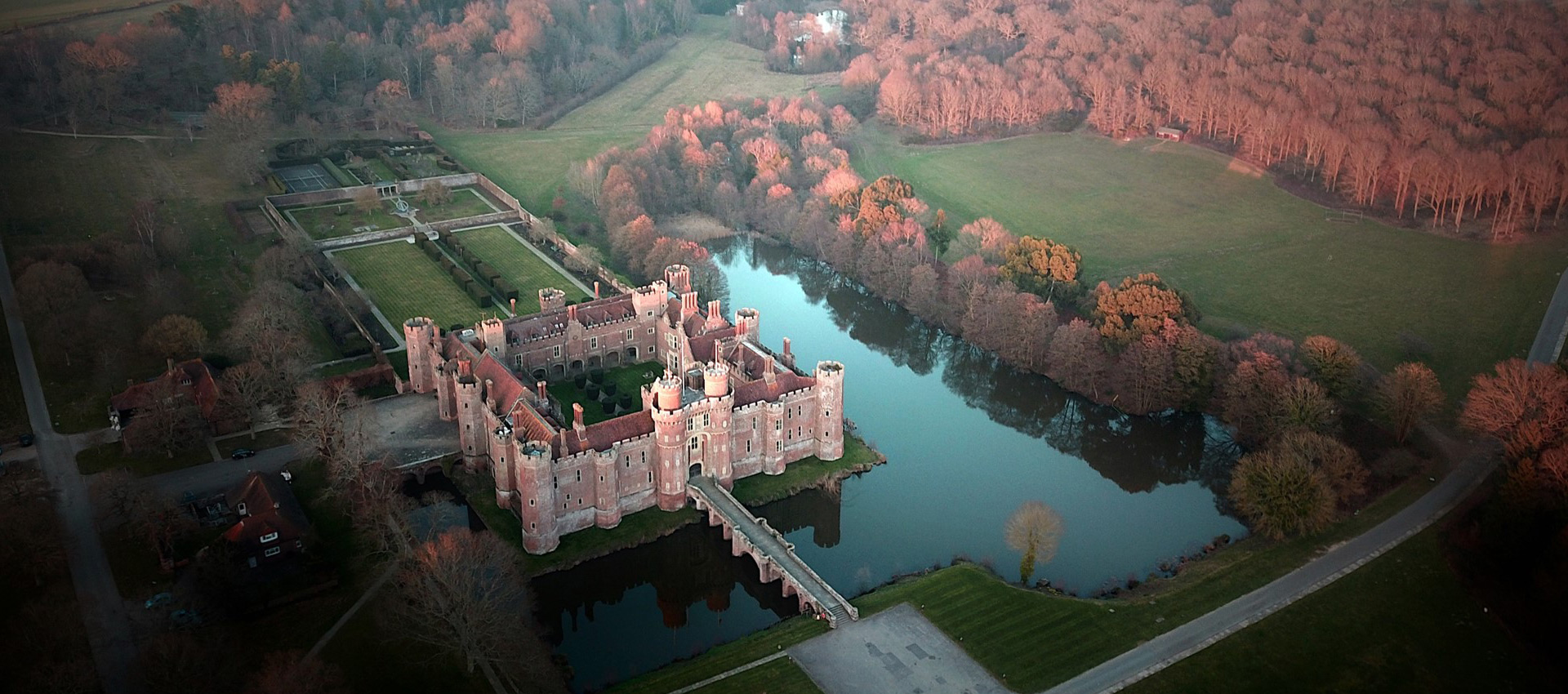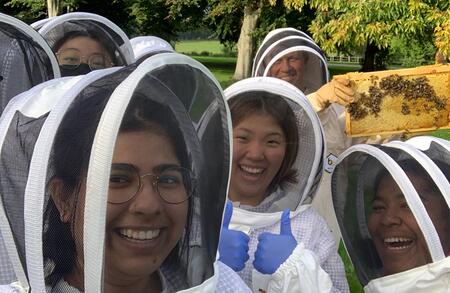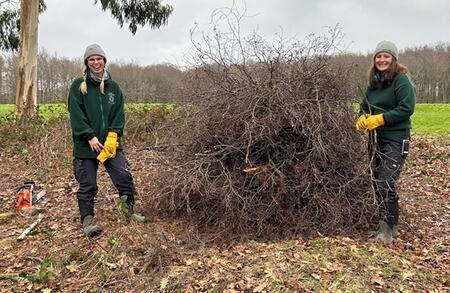A living laboratory

Proud custodians of the Castle Estate
At Bader College, our aim is to become a site where the notions of global citizenship, and agency in young people are not merely championed, but the human impact of a sustainability-focused ethos becomes tangible.
 Our approach towards nature restoration applies to the Estate’s various ecosystems – whether this is coppicing in our ancient woodland, sloughing of water through our ponds, or seed establishment in our wildflower meadows, for example. As champions of conservation, we are absolutely committed to enhancing and preserving pockets of biodiversity on the Estate.
Our approach towards nature restoration applies to the Estate’s various ecosystems – whether this is coppicing in our ancient woodland, sloughing of water through our ponds, or seed establishment in our wildflower meadows, for example. As champions of conservation, we are absolutely committed to enhancing and preserving pockets of biodiversity on the Estate.
Our Estate is home to a staggering variety of indigenous flora and fauna which includes ancient chestnuts, wild orchids, rare fungi, woodpeckers, kingfishers, buzzards and both roe and fallow deer. Our ponds and wetlands contain a variety of important wildfowl, commonly associated with the Pevensey Levels; including lapwings, yellow wagtails, cuckoos, marsh harriers and a resident heron that patrols the castle’s moat.
Our students taking the Sciences are encouraged to use the 600-acre Castle Estate as a living laboratory, collecting samples and performing experiments on the rich variety of ecosystems and land forms that are present on the Estate.
As a student, you receive exceptional opportunities to link the biodiversity and specialized habitats that make up your surroundings with enquiry-based labs and key course concepts. It's also a fun way of enjoying nature and getting lungs full of fresh air in between lectures!
Bees & Trees
 The Bader Skills Award has an Ecology & Land Stewardship component with a module we have dubbed ‘Bees & Trees’. The course provides an introduction to pollinators and bee husbandry, offering the students a chance to suit up and observe the activities in one of the Estate’s two new apiaries.
The Bader Skills Award has an Ecology & Land Stewardship component with a module we have dubbed ‘Bees & Trees’. The course provides an introduction to pollinators and bee husbandry, offering the students a chance to suit up and observe the activities in one of the Estate’s two new apiaries.
‘Bees & Trees’ is just one example of our desire for students to appreciate the beauty and diverse ecology of the Estate all around them, and with the UN Sustainable Development Goals firmly in our minds, get our BSA students thinking about how their own actions affect the natural world around them. Speaking at the Principal’s Teaching and Learning Award for International Education Innovation ceremony earlier this year, Patrick Deane said,” The impact that this initiative has on students’ self-awareness at Bader College is so very clear and commendable. They will be able take this with them through their education and beyond.”
The aim of the Ecology and Land Stewardship BSA module is to engage students in hands-on activities that contribute in a meaningful way to the land management of the Estate. Our students will get to experience, and we hope fully appreciate the different ecosystems on their doorstep, from studies of the bees in our orchards and biodiversity surveys in our wildflower meadows, to setting floating footprint traps in our moat to check for the presence of otters, water voles and mink.
Mink Rafts
 This floating monitoring system encourages curious animals to climb on it to explore and as they do, they leave evidence of their presence in the form of footprints in sand and clay spread across the raft.
This floating monitoring system encourages curious animals to climb on it to explore and as they do, they leave evidence of their presence in the form of footprints in sand and clay spread across the raft.
The original idea was to check for the presence and then subsequently survey the population of invasive American Mink (Neogale vision) in the waterways across the Estate.
The students build the rafts from scratch and often display some highly competent woodworking skills. We should also say a massive “Thank you!” to the folks at Men's Shed for supplying the tools and wood.
It is hoped that the survey raft’s footprint trap will also show the presence of otters and water voles across the Estate so we can start to compile a picture of their numbers.
It is believed American Mink escaped from fur farms in the UK during the 1950s and 1960s and their descendants have been on the run ever since. Mink may look cute and cuddly, but they are very active predators that will feed on anything they can get their paws on, including nesting birds and endangered water voles.
Wetland Management
 All our ponds excluding the moat are designated Sites of Special Scientific Interest (SSSI) by Natural England due to the existence of rare fen vegetation such as Cornish moneywort, Milk parsley and Water violet. The ponds are also managed as ponds of high wildlife value. Onwards from the moat, our waters feed the Kentland Fleet, becoming part of the Pevensey Levels National Nature Reserve (SSSI, RAMSAR and SAC).
All our ponds excluding the moat are designated Sites of Special Scientific Interest (SSSI) by Natural England due to the existence of rare fen vegetation such as Cornish moneywort, Milk parsley and Water violet. The ponds are also managed as ponds of high wildlife value. Onwards from the moat, our waters feed the Kentland Fleet, becoming part of the Pevensey Levels National Nature Reserve (SSSI, RAMSAR and SAC).
Our volunteer Ecology and Land stewardship group meet approximately once a term to remove a number of invasive species identified up by the Folly Pond. Under supervision, students will remove horsetails, bulrushes and other invasive species from the pond margin to provide room for regionally rare and protected species, such as milk parsley, which is the food source of the caterpillar of the Swallowtail butterfly, to flourish.
Horsetail is an invasive, deep-rooted perennial weed that spreads quickly to form a dense carpet of foliage on and around our ponds. It’s what’s known as a pernicious plant, which might seem a little harsh, but left unchecked, it would crowd out less vigorous plants in our beds and borders and take over completely.
Clearing our pond margins creates channels so that small water birds and mammals can navigate them more easily, encouraging them to make nests in which to raise their young. Waders are provided!
Coppicing Work
 Most recently, our Estate Management team have been re-coppicing the Alder trees around the moat to deliver several benefits to the area.
Most recently, our Estate Management team have been re-coppicing the Alder trees around the moat to deliver several benefits to the area.
A primary benefit will be to create a low shrubby habitat around the pond, providing homes for our feathered friends, which include lapwings, yellow wagtails, cuckoos, marsh harriers and a resident heron.
Secondly, coppicing some of the trees will allow more sunlight into the moat, which will encourage a greater diversity of aquatic plants, insects, and amphibians – with the additional benefit of unobstructed views of the Castle upon arrival when our tourist visitors return of course! The gardens and grounds of Herstmonceux Castle are a popular tourist attraction between February and October, attracting upwards of 30,000 visitors each season.
Student volunteers lent a hand, creating dead-hedges (a way of putting our woody pruning to good use and providing an instant habitat for insects and beetles, and thus a rich feeding ground for small mammals such as hedgehogs.) and piling up logs to create hibernacula.
The term hibernaculum, the plural form of which is 'hibernacula' comes from the Latin, "tent for winter quarters" and refers to any place in which a creature seeks refuge from the elements. Providing such habitats enriches our ecosystems and helps ensure as little waste as possible from unavoidable tree felling work.
Meadow Making
 Since the 1930's the UK has lost 97% of UK wildlife meadows and so we are very happy to be expanding our habitat here at the Castle. Wildflower meadows support our soils, pollinators, wildlife, and even our own well-being. The Estate Team collect wildflower seeds in the summer from our very own ‘mother meadow’, and we call for the students' many hands to help us scatter in a new meadow location. It's a fun task, with no experience needed!
Since the 1930's the UK has lost 97% of UK wildlife meadows and so we are very happy to be expanding our habitat here at the Castle. Wildflower meadows support our soils, pollinators, wildlife, and even our own well-being. The Estate Team collect wildflower seeds in the summer from our very own ‘mother meadow’, and we call for the students' many hands to help us scatter in a new meadow location. It's a fun task, with no experience needed!
Each new cut affords the opportunity for new species to establish a foothold up at the existing meadow, while simultaneously seeding a brand new area of the Estate to boost our overall levels of biodiversity.































